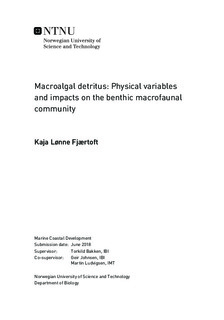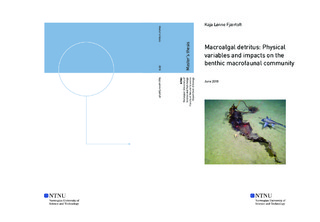| dc.description.abstract | Marine primary productivity by micro- and macroalgae in Norway, limited to the photic zone (0 200 m depth), controls the amount of organic carbon (food) available to higher trophic levels, and is the basis for marine biodiversity and productivity. Recent studies have revealed new habitats dominated by kelpfalls (concentration zones with macroalgae detached from their hard substrate, including kelp detritus/fragments), and indications that these may play an important part in the vertical transport of organic carbon and energy to the aphotic zone. Macroalgal fragments has been documented on the seabed (ranging from shallow waters to the deep sea), and there is an increased focus by researchers to investigate the impact of the detritus on the benthic organisms in the deep sea and fjord environments. Physical parameters impact the transport of organic carbon to the marine benthic organisms in the deep. High current speed can have an impact on the size of particles that reach the seabed, and high variation in seafloor morphology has been linked to a build up of organic content on the seafloor.
The study aimed to document the occurrence of macroalgae fragments, its impact on the benthic macrofaunal biodiversity, and occurrence of phytoplankton pigments on the seabed. Furthermore, investigate the impact of physical parameters and assess the use of a Remotely Operated Vehicle (ROV) as a mapping tool. The study was conducted 6 km south of the mouth of the Trondheimsfjord, Norway. Macroalgal fragments and benthic macrofaunal biodiversity where documented by video transects following the European Standard for visual seabed surveys. Sediment grain size and occurrence of potential phytoplankton pigment were investigated from box core sediment samples. A link was found between higher variation in seafloor morphology, an increase in biodiversity, coarser grain size of bottom surface sediment and a higher occurrence of macrofaunal fragments. Results indicate an increase in taxa biodiversity, especially with respect to occurrence of macroalgal grazers, with the presence of macroalgal fragments. Biofilm from sedimented phytoplankton were not found in surface of bottom sediments (HPLC analysis of pigments). The ROV video transects allowed for identification and distribution of taxa on the seabed, but several problems were encountered with species identification due to low image resolution and using external morphology for identification. Additionally, the need to develop alternatives within the European Standard depending on baseline data available and ecosystems of interest was identified. Macroalgal fragments may play a large role in carbon sequestration and in supplying food to benthic organisms in the deeper parts of the ocean. Further studies, with a multidisciplinary approach, is needed to identify the pathways of transport to the deep and its impact on the life below. | |

